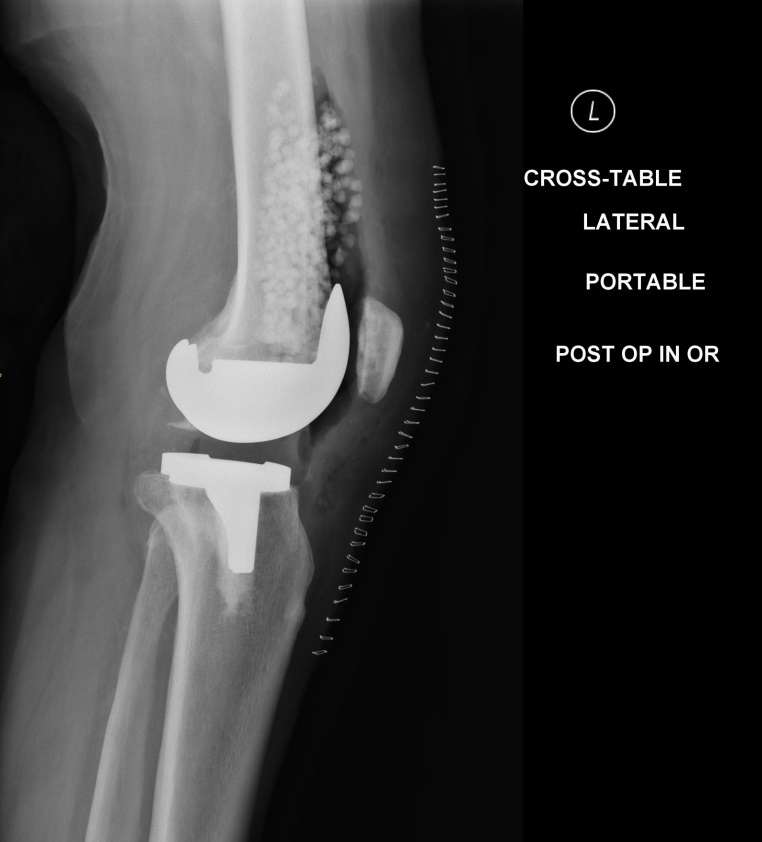Peer Reviewed
Streptococcus canis Infection of a Prosthetic Knee Joint
Authors:
Valentina S. Maksymyuk
Senior Medical Student, New York College of Osteopathic Medicine, Old Westbury, New York
Arfa Mirza, DO
Chief Resident in Family Medicine, Peconic Bay Medical Center–Northwell Health, Riverhead, New York
Sandeep A. Gandhi, MD
Infectious Diseases Consultant at Peconic Bay Medical Center, Riverhead, New York, and Associate Professor of Clinical Medicine, New York Institute of Technology College of Osteopathic Medicine, Old Westbury, New York
Citation:
Maksymyuk VS, Mirza A, Gandhi SA. Streptococcus canis infection of a prosthetic knee joint [published online August 26, 2019]. Infectious Diseases Consultant.
A 73-year-old man with a history of hyperlipidemia, hypertension, diabetes, and degenerative joint disease who had undergone left knee total replacement approximately 3½ years ago presented with a 1-day history of sudden-onset severe left knee swelling, warmth, pain, and an inability to bear weight. The symptoms were associated with fever and chills.
The patient denied any recent trauma, dental treatments, or travel. He reports that he has a dog that licks him.
On initial presentation, his vital signs were stable. The left knee was swollen, mildly erythematous, and warm, with tenderness to palpation. Active and passive range of motion of the left knee was restricted due to pain. The rest of the physical examination findings were within normal limits.
Orthopedic evaluation with aspiration of his left knee was performed, the results of which revealed 80,000 white blood cells/µL with 89% polymorphonuclear neutrophils. Bacterial cultures of synovial fluid grew group G streptococci and, specifically, Streptococcus canis. Fungal cultures and acid-fast stain of the synovial fluid and blood cultures were negative.
The patient underwent a left knee excisional debridement with irrigation and exchange of the modular tibial bearing. Cefazolin-coated beads were placed in the left knee joint during the procedure (Figures 1 and 2). He also was treated with intravenous ceftriaxone for 6 weeks, which led to complete resolution of his symptoms.

Figure 1. Cefazolin-coated beads in left knee joint, lateral view.

Figure 2. Cefazolin-coated beads in the left knee joint, anteroposterior view.
DISCUSSION
S canis is a group G streptococcus. Group G streptococci react with Lancefield group G typing serum and, like Streptococcus pyogenes (a group A streptococcus), form large colonies on sheep blood agar, typically surrounded by a zone of β-hemolysis.1,2
S canis colonizes the skin, the upper respiratory tract, and the reproductive tract of dogs, cats, and cattle. S canis is also an important pathogen of these species, causing skin and genitourinary tract infections, otitis externa, pneumonia, endocarditis, septic arthritis, septicemia, necrotizing fasciitis, and streptococcal toxic shock syndrome.3
Under certain circumstances, these bacteria can cause opportunistic infections in mammals, including humans.3 The portal of entry in one case report was through a dog bite,4 while in a second case the portal of entry was suspected to be through leg ulcers of a dog owner.5
Instances of mortality from S canis in humans are very rare. In a US prospective survey in 2003 and 2004, the proportion of S canis among group G streptococci isolated from human invasive infections was only 2.6%.6 Like other streptococci, S canis have a virulence factor, M protein, which has high affinity for human immunoglobulin G and plasminogen, forming plasma-soluble complexes.7 S canis M protein–mediated plasma complexes harbor complement component C1q, which can induce complement breakdown in the periphery and therefore represents the immune evasion mechanism of S canis.8
Although human S canis infections are rarely reported, S canis infections may have been previously underdiagnosed due to the fact that group G streptococci are not systematically identified to the species level in the clinical setting.9 Moreover, Streptococcus dysgalactiae subsp equisimilis and S canis both form β-hemolytic large colonies, and biochemical identification of S canis is difficult.10
This patient’s case is unusual, because S canis caused monoarthritis of the knee joint without an open wound or a dog bite, which are the standard entry points for this pathogen. Apparently, the mechanism of infection was that the patient’s dog licked the patient’s face and lips, transmitting bacteria through the oral mucosa into the bloodstream, then seeding into the knee joint.
Hardware removal would be the ideal treatment; however, in our patient’s case, debridement with irrigation and exchange of the modular tibial bearing with cefazolin antibiotic bead placement in the infected joint resolved the infection.
- Baracco GJ. Infections caused by group C and G streptococcus (Streptococcus dysgalactiae subsp. equisimilis and others): epidemiological and clinical aspects. Microbiol Spectr. 2019;7(2). doi:10.1128/microbiolspec.GPP3-0016-2018.
- Jensen A, Kilian M. Delineation of Streptococcus dysgalactiae, its subspecies, and its clinical and phylogenetic relationship to Streptococcus pyogenes. J Clin Microbiol. 2012;50(1):113-126.
- Pinho MD, Foster G, Pomba C, et al; Portuguese Group for the Study of Streptococcal Infections. Streptococcus canis are a single population infecting multiple animal hosts despite the diversity of the universally present M-like protein SCM. Front Microbiol. 2019;10:631.
- Takeda N, Kikuchi K, Asano R, et al. Recurrent septicemia caused by Streptococcus canis after a dog bite. Scand J Infect Dis. 2001;33(12):927-928.
- Bert F, Lambert-Zechovsky N. Septicemia caused by Streptococcus canis in a human. J Clin Microbiol. 1997;35:777-779
- Broyles LN, Van Beneden C, Beall B, et al. Population-based study of invasive disease due to β-hemolytic streptococci of groups other than A and B. Clin Infect Dis. 2009;48(6):706-712.
- Bergmann S, Eichhorn I, Kohler TP, et al. SCM, the M protein of Streptococcus canis binds immunoglobulin G. Front Cell Infect Microbiol. 2017;7:80.
- Nerlich A, Lapschies A-M, Kohler TP, et al. Homophilic protein interactions facilitate bacterial aggregation and IgG-dependent complex formation by the Streptococcus canis M protein SCM. Virulence. 2019;10(1):194-206.
- Galpérine T, Cazorla C, Blanchard E, Boineau F, Ragnaud J-M, Neau D. Streptococcus canis infections in humans: retrospective study of 54 patients. J Infect. 2007;55(1):23-26.
- Facklam R. What happened to the streptococci: overview of taxonomic and nomenclature changes. Clin Microbiol Rev. 2002;15(4):613-630.


